To make a blog post is fairly easy to do, especially with the help of previous classmates posts. First, you go to the class website using the appropriate URL. Then, you sign up for the correct class time and add yourself to the website. The next step to make a post is click on the box that says “+New”, located at the top of the screen and that will bring you to a new page that says “Add Post”. From there, you create a title for your post, write something for the body, and choose the appropriate categories and tags, and finally hit post. So simple!
Author: Cassandra J. Moseley
Final Project (Museum Tour)
Cassandra Moseley
Professor Shaw
Art 1010
Humanism became prominent in the Ancient worlds of Greece and Rome, which are very intertwined with one another. Humanism revolves around the Beauty of the Human form and its Essence. Humanism during the Greek and Roman era of artwork put humans at the center of everything; the human experience is at the center of all events in contrast to previous societies that put God at the center of everything. As time proceeds we begin to see an evolution of Humanism in which different elements begin to enhance this concept, most of which is seen through statues of men and women that were either prominent figures or part of mythology. Though, the evolution of Humanism can be seen through the different works of art that depict children during these Ancient times. Today, I will take you on a museum tour to explore the theme of children being depicted in artwork and their clear demonstration of the evolution of Humanism throughout the Ancient Worlds. We will begin the tour starting with Ancient Egypt.
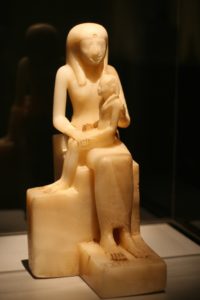
This first image is Statue of Queen Ankhnes-myre II and her son, Pepy II, ca 2288-2224 or 2194 B.C.E., at the Brooklyn Museum. I am beginning this tour with this piece of artwork from the Old Kingdom of Ancient Egypt. During this time, artwork still revolved around the different Egyptian Gods meaning that humans were not considered to be at the center of the universe at this point. I chose to begin with this particular piece because it is one of the first, and few times we see a child in artwork. In beginning the tour with this piece we can see that the child does not phenotypically display accurate representations of what children look/looked like. The child does not have any characteristic child features that would instantaneously make us assume that this was in fact a child. In the way the child was made to look in this piece, he just looks like a smaller version of an adult, again because he lacks resemblance to children. This piece of work is good to keep in mind as we explore the next few pieces.

The next image I wish to bring your attention to is Hermes with the Infant Dionysus, 4th century by Praxiteles at the Archaeological Museum of Olympia. Here we move into Ancient Greece where we see the development of Humanism. During this time we begin to see more art revolved around humans and the human body. I felt as though this piece was important to show on the tour because we can clearly see the evolution of Humanism in Hermes, but we can also begin to see the development through infant Dionysus. Here we begin to see physical features of children that are similar to what we see in our everyday lives. Dionysus has the round and full face that infants often have as well as a smaller and pudgier body. I believe that this clearly shows development of Humanism in children because if the name of the piece was not given, a viewer could still identify that a child is being represented.

Next, we will look at Marble grave stele with a family group, ca. 360 B.C., Late Classical at the Metropolitan Museum. I brought you to this piece in particular so that we could observe a few details in this piece. In this marble grave stele we can take note of the two women and man, and the chid holding hands with who we could assume is her mother. I chose to show this piece because just like the previous sculpture, we can see a clear representation of a child, this time a little girl. At this point we can see through examining the child that the depiction of Humanism has begun to evolve. One observation we can take into account is the use of size to show that she is in fact representing a young girl. The mother’s hand that is holding the young girl’s hand is noticeably larger than the young girl’s. I would like to point this out because it looks slightly exaggerated, but it can be assumed this was done to show that this a very young child, perhaps between the ages of 5-8. Then, when we take a look at the young girl’s face it is hard to decipher her age range, and if the body were to be gone such as the case with the woman to the left of her, one could argue that it would be difficult to tell that she was a little girl. The size of the head could signify that she was supposed to be a young girl, but the facial features could make one weary. This is why I chose this piece, size is used to clearly depict a child in this family, but the facial features are similar to those of pieces of artwork depicting women. The child has softer features to show a child, but the overall face is still similar to a woman’s. This piece shows evolution in Humanism through the young girl, but there is still an ongoing use of adult-like features on young children at this point in time.

One other piece we will be observing and examining briefly is Bronze statue of Eros sleeping, 3rd-2nd century B.C., Hellenistic Period at the Metropolitan Museum. Even though this piece is representing mythology, we can see obvious evolution of Humanism through Eros being depicted as a child. Brief background for the Hellenistic Period that we are entering is that during Alexander the Great’s reign we see a change and evolution in Humanism. During this time, we begin to see more works of art showcasing different subject matter as well as accurate characterizations of age. On that note, we can really appreciate the details of this piece, which is why I brought you to this piece next. In this piece, even though it is a representation of Eros, we have a child as the main subject matter. In this sculpture we can clearly see many different physical features that are being used to show that this is a child, instead of the reliance on size. Here we see the use of softer lines for Eros’ body in order to give the body a softer and more plush appearance, physical features we expect to see in a child in real life. We even see Eros with chubby feet, again another physical feature that is associated with very young children. Now if we take a look at Eros’ face, the use of soft lines and grooves is used to, again, give the face a softer and rounder look. Also, the tousled curls that Eros has gives him another young boyish feature. I chose this piece because it coincides perfectly with my theme of the evolution of humanism depicted through children. Evolution of Humanism was evident during the Hellenistic Age especially with their true and accurate depictions of children. Here we see more focus on physical features to represent specific age groups instead of the use of size.

The last picture I will bring your attention to is Bronze statue of a camillus (acolyte), Roman A.D. 14-54, Early Imperial, Julio Claudian at the Metropolitan Museum. As time went on the Romans also began to use more children as subject matter, and there was a focus on physical features depicting accurate age. When taking a look back to the previous pieces and now to this one, we can really begin to appreciate the development of Humanism as time went on. Just like the previous piece, in this Roman sculpture we can appreciate the accurate child-like physical features of this young boy. Here, soft lines and grooves are used for his physical features to once again show that he is a young boy. Although his hair isn’t tousled like Eros, it is cropped, but boyish curls are still depicted giving this child a more youthful look. When looking at his face, we see another depiction of a round and soft face to show the youthfulness of this boy, something we associate with children. We also see a slight smile and the softness of the apples of his cheeks, a physical feature that is prominent amongst children. I wanted to point out this physical feature on the boy because it is one of the most child-like physical features to the point where we have a saying “…so cute I could pinch your cheeks”, which is most often said to children; and the Romans captured this so perfectly. We also see his body as having the correct ratios and proportions to that of a real human child. I believe that this was a good sculpture to close on because we can see through this statue that as civilizations evolved we begin to see the evolution in their detailing to accurately portray the human world. This piece helps to further the idea that children accurately display the development of Humanism throughout the Ancient worlds that we have explored and previous learned about in detail.
I would like to end this tour with some final thoughts about the explored theme and pieces of art works that we examined. In the beginning I proposed to you the idea that while men and women are mostly used to show the development of Humanism throughout the Ancient Worlds, children in artworks accurately show the evolution and development of Humanism. Throughout the different pieces that I showed we begin to see artistic development along with civilization development. In beginning with the piece Statue of Queen Ankhnes-myre II and her son, Pepy II, and then examining the other pieces we can truly appreciate the development of artist’s attention to physical features when it comes to the depiction of children; size is no longer the main detail used to depict children. We began to see the use of softer lines and grooves and accurate proportions in order to accurately represent children in the art world, and their classic physical features that make a viewer instantly assume that a child is being shown. The children in artworks perfectly show the development and evolution of Humanism in the art world.
Works Cited
“Bronze Statue of Eros Sleeping.” Khan Academy, Khan Academy, www.khanacademy.org/humanities/ancient-art-civilizations/greek-art/hellenistic/v/enamored.
Hemingway, Colette, and Seán Hemingway. “The Art of Classical Greece (ca. 480–323 B.C.).” In Heilbrunn Timeline of Art History. New York: The Metropolitan Museum of Art, 2000–. http://www.metmuseum.org/toah/hd/tacg/hd_tacg.htm (January 2008)
Hemingway, Colette, and Seán Hemingway. “Art of the Hellenistic Age and the Hellenistic Tradition.” In Heilbrunn Timeline of Art History. New York: The Metropolitan Museum of Art, 2000–. http://www.metmuseum.org/toah/hd/haht/hd_haht.htm (April 2007)
Nichols, Marden. “Contexts for the Display of Statues in Classical Antiquity.” In Heilbrunn Timeline of Art History. New York: The Metropolitan Museum of Art, 2000–. http://www.metmuseum.org/toah/hd/disp/hd_disp.htm (April 2010)
Final Project Bibliography
Hemingway, Colette, and Seán Hemingway. “The Art of Classical Greece (ca. 480–323 B.C.).” In Heilbrunn Timeline of Art History. New York: The Metropolitan Museum of Art, 2000–. http://www.metmuseum.org/toah/hd/tacg/hd_tacg.htm (January 2008)
“The middle of the fifth century B.C. is often referred to as the Golden Age of Greece, particularly of Athens. Significant achievements were made in Attic vase painting. Most notably, the red-figure technique superseded the black-figure technique, and with that, great strides were made in portraying the human body, clothed or naked, at rest or in motion.” This quote gives a brief explanation as to what Humanism is and how the Greeks began portray in their works of art. As was mentioned, Humanism focuses on the physical human body whether their is clothing involved or not. This essay relates to my project because it gives a look into the timeline of Greek art and when Humanism began to be showcased, and its evolution over the different time periods.
Hemingway, Colette, and Seán Hemingway. “Art of the Hellenistic Age and the Hellenistic Tradition.” In Heilbrunn Timeline of Art History. New York: The Metropolitan Museum of Art, 2000–. http://www.metmuseum.org/toah/hd/haht/hd_haht.htm (April 2007)
I chose to use this essay because it goes onto explain the Hellenistic Age and how it came about. It gives details on Alexander the Great and the adaptations that were taken on during this era. This essay also explains that the Hellenistic kings were endorsers of the arts, and more than often paid for lavish paintings and sculptures to showcase their wealth. Then it is explained that during the Hellenistic age, the arts took a different turn and developed their own “spin” on Humanism in which it became richly diverse in subject matter, and representations of Greek gods took on a different form. For example, the main reason I chose this essay is because it goes on to discuss the Eros who is the Greek personification of Love, takes on the form of a young child. Lastly, the essay goes on to explain that during this era we see increased use of children as the subject matter who are considered conventional inhabitants.
Final Project Outline (Museum Visit)
Starting in the period of Roman art, we began to see more children depicted in sculptures in which they began to resemble more and more what a child looks like in real life. I am using the museum visit to explore the idea that children are used in artworks to provide different a different perspective and to showcase the evolution of humanism throughout the Ancient Worlds.
Image List:
Statue of Queen Ankhnes-myre II and her son, Pepy II

Bronze statue of a camillus (acolyte), Roman A.D. 14-54, Early Imperial, Julio Claudian

Praxiteles Hermes with the Infant Dionysus,

Marble grave stele with a family group, ca. 360 B.C., Late Classical

Bronze statue of Eros sleeping, 3rd-2nd century B.C., Hellenistic Period

Blog Post 10: Met Museum Visit
The Met Museum is always quite the experience when you go. I actually went to the Met earlier this year, a little bit after the Met Gala and it was so stunning. Visiting the Met again, I got the same feeling especially because of the holidays and their decorations. I will say that I went during a busy time, so it was more difficult to navigate and fully enjoy, but it was all in all another good experience
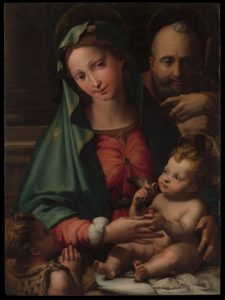
For my Renaissance piece I chose The Holy Family with the Infant Saint John the Baptist by Perino del Vaga. I chose to use this painting because I believe that it shows a lot of what Renaissance paintings embody. This picture shows the viewer a sense of serenity through the colors used and the light emotions on the faces. The painting also uses vertical and horizontal view points that are resembled throughout Renaissance artworks. In this painting, as a viewer, your eyes are drawn into the center of the painting, but then subtly brought in a vertical and horizontal point of view to see the clothes child and older man in the painting.
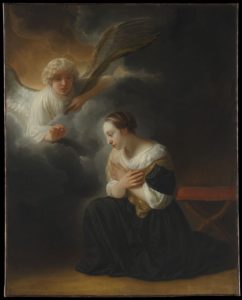
For the Baroque work of art I chose The Annunciation of the Death of the Virgin by Samuel van Hoogerstraten. This painting really caught my attention because of the light contrast that is very evident, and the lighting effects that can be seen are actually a characteristic of Baroque pieces. Another characteristic that this piece shows is the effects of directed focus which is demonstrated by the use of lighting. There is a deep contrast between the dark background and the center of the painting, which causes some of the center to be the focus of the painting. This painting also uses diagonals where your eyes are brought to the angel in the upper left corner and then down to the virgin in the right corner, making a diagonal perspective. Lastly, emotions can be clearly seen through the body language of the Virgin, in which seems in despair but also content; there is no harsh or dramatic emotion of sadness for death.
Final Project: Topic
For the final project I have decided to explore the use of children in art works and what kind of significance they portray. For example, in the Roman era we begin to see the use of children in different sculptures in order to bring the viewers gaze to the lower portion of the artwork. I would like to explore children’s significance in each era in which they begin to appear.

Blog Post: Unit 2 Summary
The past few months we have examined different art works and their relevant history in Ancient civilization such as Mesopotamia, Egypt, Greek, and Roman. All of these civilizations had many things in common, but also many differences.
For example, both Ancient Mesopotamia and Ancient Egyptian art shared the value of Gods. The Gods were the main focus of art for these civilizations, but were expressed in different ways and had visible physical differences. In Ancient Mesopotamia, the Gods were worshipped extensively as a way to avoid bad fortune. This civilization believed that if bad things were to happen to the community, for example bad crops, then this was because they were not pleasing the Gods enough. Statuettes were made, such as the Standing Male Worshipper, as a way to show the Gods that even though they were working or doing other everyday activities, they were still worshipping and praying to the Gods. When looking at this statue, some “identifiers” of Mesopotamian art are big eyes, long hair organized in a uniform manner, and hands folded in prayer. In Ancient Egypt, the Gods were worshipped as well and played a huge part in the civilizations narrative, but we begin to see more sculptures and artwork regarding Pharaohs, who were considered to be the mediators between the Gods and the people. When looking at Ancient Egyptian art, specifically Menakure and Queen we begin to see some differences. For example, although the similarity is that both sculptures are clothed, one important thing to note is the fact that the Pharaohs feet do not touch the ground, this was to signify that he was above the people and closer to the Gods in social class. This sculpture is also more polished.
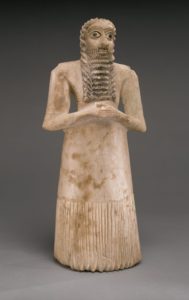
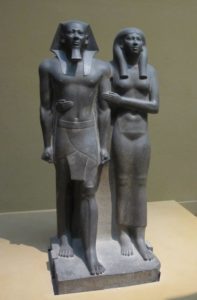
Moving on to Greek and Roman art, there are many similarities that arise then there is a shift to new differences as new eras arise. During Greek and Roman Art, there began to be a new emphasis on Humanism, which is focusing and emphasizing on the human as the main object of the world instead of the Gods. In addition to that, Humanism focuses on the human beliefs, values, and individuality. Humanism can be seen in Discobolus, in which the physical human body is clearly emphasized. In strong contrast to the previous artworks that were mentioned, this sculpture portrays the naked human body. The Greeks saw the human body as something to take pride in and to value, and instead of using headpieces and other things to signify power, they allowed the human body to signify power and strength. Lastly, we delved in to the history of the Roman Republic which once again showed a change in the expression of artwork. The Roman Republic still fixated on humanism, but now emphasized verism which means truth-telling. Verism was used to show the Roman Republic’s value of age, wisdom, and real human emotion/personality traits. For example, looking at this sculpture, we see that this man does not have a polished face to show youth, which can be seen in previous Greek and Roman art, instead we see effort to make the man’s face have very noticeable wrinkles. The Roman’s wanted to display age because it was now deeply valued and age meant that someone had a lot of wisdom to give. In this sculpture, we also see emotion, but not dramatic emotion. In this era emotions displayed in the artworks were more realistic and in-tune with a person’s own personality traits. In this sculpture, we could simply say that man just seems ill-tempered or grumpy.


Blog Post: Humanism
Thus far the Ancient Worlds that we have learned about in class tended to create works of art that were more naturalistic instead of humanistic. Examples of Ancient Worlds that focused on naturalistic art were Mesopotamia and Egypt, where there was more of a focus on the Gods and that everything else was surrounded by the Gods. In contrast, Greek and Roman art focused on humanism. Humanism focused and emphasized humans as the “main object” of the world and that instead of Gods, humans were, in a way, at the center of the universe. Humanism focuses on human values, beliefs, and individuality; and that humans have the capability to be good. In terms of Greco-Roman art, humanism meant putting an emphasis on the human potential, as well as the human body.

For example, in the Ancient Egyptian sculpture, Seated statue of Pharaoh Seti (*picture would not upload), humanism is not portrayed. In this sculpture, the human body is not emphasized and instead his rank his emphasized. For this piece of artwork, the eyes are instantly drawn to the Pharaoh’s headpiece, the object in hand, and his feet that are on top of an object in order for them to not touch the ground. All of these observances can instantly make the viewer come to the conclusion that this person was in fact a Pharaoh and therefore of very high rank. In addition to that, the Pharaoh’s body is not emphasized, and instead the viewer can see the outlining of the garments that the Pharaoh wears, once again demonstrating social class and power.
In contrast, in this Greek sculpture, Discobolus, humanism is very evident. Most noticeable is that the naked human body is on display, clearly showing human emphasis. The Greeks saw the display of the human body as something natural and something “show off” and take pride in. Their bodies showed their strength and exuded their power. The Greeks did many things in the nude, as it was considered the norm, even the Olympics were done in the nude. This sculpture does not put an emphasis on rank or social class, it is ambiguous and is left for the viewer to assume.
Blog #7 Brooklyn Museum-Soul of a Nation

Although, I was anticipating all of the works I would encounter at the Brooklyn Museum, I was most interested and excited to explore the Soul of a Nation exhibit. This is an exhibit that now holds a special place in my heart after experiencing it and getting to see the work of many Black artists and the different depictions of blackness across the US (NY, Chicago, L.A.). One of my favorite parts was all of the work depicting the Black Panthers and their movement. I’ve always had a fascination with the Black Panthers movement because of the stories my dad would tell about them and things he experienced growing up in the era of their movement.
Although, this part of the exhibit was something I was increasingly interested in, I found myself instantly drawn to this painting of the American Flag, named American People Series #18: The Flag is Bleeding, 1967 by Faith Ringgold. I went back to this piece about three times, each time finding some new meaning and new emotion in regards to it. I chose to post this piece because in this recent political climate and over the past few years, more and more people have become vocal about the oppression faced by Black people everyday. In this work, it depicts that in America we all stand united and in solidarity, but in reality once you look beyond this stance it can be seen that that isn’t the truth. The oppression of Blacks had never diminished and as said previously, can still be seen today. This piece relates to the rest of the exhibit because the main focuses of it are discrimination and oppression, and the Civil Rights Movement that fixated on fixing these problems. This piece embodies both discrimination and oppression of Blacks, even though we are all given these rights under the Constitution and should be united from it, African Americans had a small chance at escaping oppression and discrimination. The colors of this work are vivid and saturated, which instantly draws your eyes to it and makes you begin analyzing it. Also, shading and shadowing are used to clearly show facial features. The color that draws your eyes in the most is the red, which is used for the stripes on the flag as well as the blood that is dripping from those stripes, once again showing not only emotional pain, but physical pain.
Blog #6: Brooklyn Museum-Ancient World
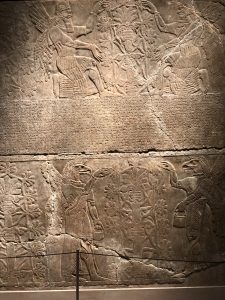
For this assignment, I was very excited to visit the Brooklyn Museum because I live right in Crown Heights and have yet to be able to visit. The museum had a beautiful layout and so many pieces that caused me to be in awe the entire time. Once I finally reached the Ancient World section on the third floor, I found myself remembering and thinking about all of the things we have learned about in class regarding Ancient Mesopotamia and Egypt, and beginning to analyze all of the wonderful works that were displayed. Upon my way out towards the stairs, I stumbled upon the Assyrian Palace Reliefs that all had amazing and intricate details that I became more appreciative of when I saw them in person. I thought the placement of the reliefs near the entrance/exit stairs was very telling as to what they are and their purpose because when you reach the beginning of the exhibit, it explains that these reliefs would be seen at the entrances of Assyrian palaces to “overwhelm” visitors. I remember discussing this in class when we learned of the many figures that would be used to showcase power and attempt to frighten visitors. The relief I found myself in complete awe of was the Relief with Two Registers that came from the Neo-Assyrian Period under the rule of Ashur-nasir-pal II. In doing formal analysis, the first thing I became aware of was the complete symmetry of the two registers. Although they are different characters, they are complete mirror images of one another, even down to the piece that the figures are holding/touching which I later found out was the sacred tree. Also, in doing formal analysis one can take note of the depth of the lines that were used, in some places of the register, both top and bottom, there are certain parts that have deeper lines and others that have more shallow lines. The shallow lines seemed to be used for parts that were not the main focus of the relief, such as clothes; and the deeper lines were used to enhance/showcase detail such as the scared tree of or the wings of the mythical creature and the genie. I also noted that unlike some of the registers we viewed in class, there did not seem to be a hierarchy and instead they were equal to show their equal importance and meaning.

